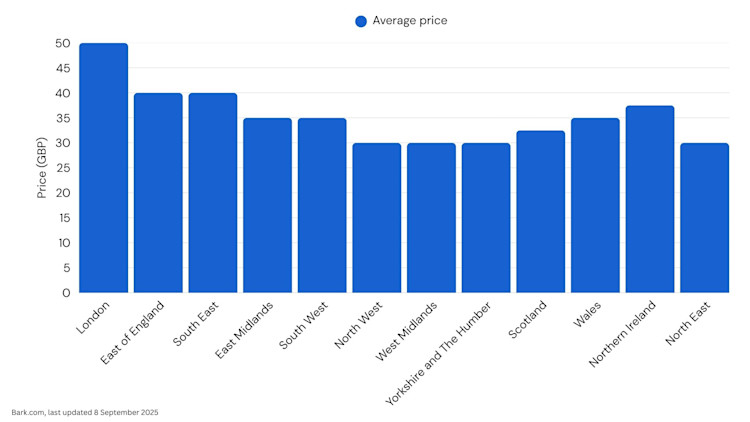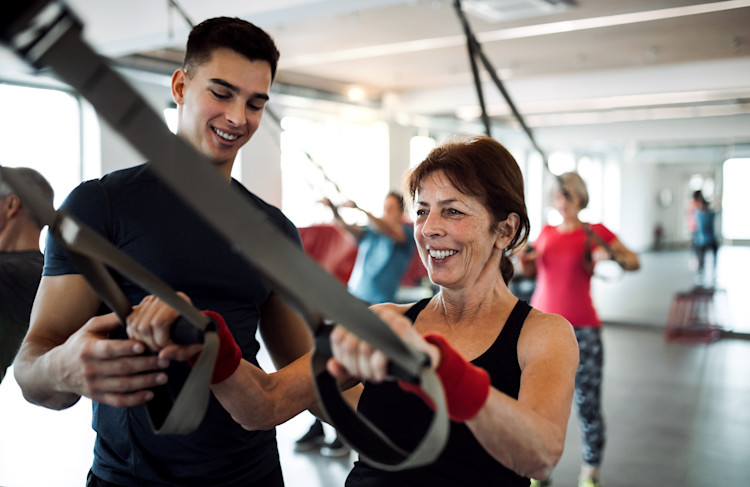Find a Personal Trainer near you
The average rating for Bark Personal Trainers is 4.93, based on 492,314 reviews
How much does a personal trainer cost? Find out with Bark's UK personal training price guide.
Last updated: 8 September 2025
When hiring a personal trainer, it's important to understand that costs vary significantly by location, the type of trainer you pick, your instructor's experience, and the session type (group vs private).
According to the last three years’ worth of data, the average cost of hiring a personal trainer in the UK is £40 per hour. However, costs can range from £25 to more than £100 per hour.
For example, an online PT is likely to be significantly cheaper than an in-person trainer in a private gym.
A Personal Trainer (PT) is a certified professional who designs safe and effective exercise programs tailored to your health and fitness goals. They provide expert guidance, support, and motivation to help with goals such as fat loss, muscle gain, or improved sports performance.

Like any professional service, the cost of a PT is based on a variety of factors. Understanding what goes into their pricing can help you find the right coach for you and your budget.
The cost of a personal trainer will be impacted by your postcode. For example, trainers in major cities, such as London and Manchester, are likely to charge more due to higher costs of living, higher gym rental costs, and greater demand. There are ways to make your personal training sessions more affordable and other factors which influence cost, so don’t worry too much if you live in an expensive area.
Popular personal training location prices*:
| Location | Average price per hour |
| London | £45-£70 |
| Manchester | £35-£45 |
| Bristol | £20-£40 |
| Edinburgh | £30-£40 |
| Liverpool | £25-£45 |

Your personal training sessions are tailored to fit your specific fitness ambitions and schedule. While sessions are commonly available in 45 or 60-minute increments, the ideal length depends on what you want to achieve. You can book sessions one at a time or create a recurring schedule that works for you. Ultimately, the cost is reflective of the session's length, which is designed to cover all aspects of your fitness plan. As to be expected, shorter sessions are generally cheaper than longer ones.
To encourage consistency, trainers often offer discounted rates for sessions purchased in packages of five, ten, or twenty. This can make things cheaper if you’re willing to commit to a training programme. Additionally, signing up for a regular schedule may accelerate your progress, meaning you might see greater benefits in a shorter timeframe.
One-on-one private training offers a fully personalised experience, allowing for the trainer's undivided attention on your specific goals, injuries, or nutritional needs. In contrast, group sessions provide a cost-effective alternative. While trainers can sometimes organise these groups, similar to a fitness class, it is more common for a group of friends or colleagues to approach a personal trainer for group sessions. By training as a group, you will lower the cost per person and add a social element to the workout.
The price of personal training often depends on where you would like your session. For the convenience and privacy of having a trainer come to your home or meet you at a private studio, costs are typically higher. A more budget-friendly option is to work with a trainer at your local gym, fitness centre or park.
When selecting a personal trainer in the UK, their certification should be a primary consideration. The fitness industry has many individuals marketing themselves as trainers without holding the necessary qualifications for safe and effective programming.
Look for trainers who are members of the Chartered Institute for the Management of Sport and Physical Activity (CIMSPA). This is the professional standard for the UK's sport and physical activity sector. The industry-standard qualification to look for is a Level 3 Diploma in Personal Training. Trainers may also hold advanced Level 4 qualifications in specialist areas like lower back pain or obesity management.
Reputable professionals will prominently display these credentials on their business profile or within their Bark profile description. While a properly certified trainer may charge a higher rate, it is a worthwhile investment in your safety, health, and results.

Working with a PT is arguably one of the smartest ways to approach your fitness journey. The biggest benefit is getting a training programme that's tailored to you, based on your unique goals, current abilities, and initial fitness level.
A large benefit of working with a trainer is that you’ll learn the correct and safe way to perform exercises. Your trainer uses their expertise to guide your form, which helps you get the best possible results while avoiding injury - a game-changer for everyone, from complete beginners to experienced gym-goers. On top of that, they provide the motivation and accountability you need to stay on track. Knowing you have a scheduled session with a supportive partner makes it much easier to show up, push past your limits, and smash through plateaus.
A great trainer also offers all-around support that goes beyond the gym floor. They can provide practical nutrition advice and help you build positive habits that complement your workouts. By also focusing on making exercise enjoyable and varied, they help you build a healthy, sustainable relationship with fitness that will last a lifetime.

Don't let cost be a barrier to achieving your fitness goals. At Bark, we can help you find the best trainer for you and your budget. Here’s how you can make hiring a PT work for your budget:
Commit and Save: Ask about package deals. Buying sessions in bulk is not only cheaper in the long run but also motivates you to stay consistent.
Train with a Team: Grab a few friends and split the cost of a session. You'll get a similar level of expert attention for a fraction of the price.
Make Every Session Count: Use a personal trainer for a weekly or fortnightly check-in to perfect your technique and get a solid plan. Then, apply what you've learned in your own workouts at the gym or in fitness classes.

Working with a trainer is, by its nature, a very personal experience. You’ll need to share lots of information about yourself, your goals and your current weaknesses in order to get the most out of your sessions. So with all this in mind, it’s important their teaching style, areas of expertise and personality suit you. Use the following tips to find, choose and hire the best personal trainer for you.
First, tell Bark what you’re looking for and what you want to achieve. Providing as much information as possible will help find the right coaches for you. Once you’ve submitted your information, we’ll send you a list of PTs ready to review. From there, you can choose the right trainer for you.
Now that you have your list of personal trainers, it's time to narrow it down and pick a trainer who's right for you. To do that, take these steps:
Deals and discounts. Most trainers offer a free or discounted initial consultation to discuss your goals, expectations, and any concerns you might have. Use this meeting to your advantage to get a feel for their personality and coaching style.
Injuries and medical history. Be sure to inform the trainer about any injuries or special health considerations. A great personal trainer will have experience modifying workouts for these issues and can create a plan for you to exercise safely.
Ask questions. Ask any questions you have about what to expect, and pay close attention to what they ask you. You can usually tell right away if the trainer is a good fit. If they are mostly silent and just nod along with everything you say, you might want to find someone who is more engaged.
Check out their reviews. On a trainer’s Bark profile, you’ll see past client reviews. Use these to understand whether other people have used a specific personal trainer to achieve the same goals as you.
* This is based upon three years’ worth of data
Average price per hour refers to the median price per hour to allow for outliers in data.
Information by city/region has only been provided where there is a large enough sample size.
The average rating for Bark Personal Trainers is 4.93, based on 492,314 reviews